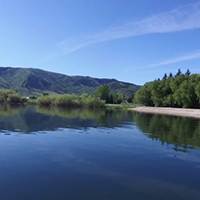Exploiting high frequency monitoring and satellite imagery for assessing chlorophyll-a dynamics in a shallow eutrophic lake

All claims expressed in this article are solely those of the authors and do not necessarily represent those of their affiliated organizations, or those of the publisher, the editors and the reviewers. Any product that may be evaluated in this article or claim that may be made by its manufacturer is not guaranteed or endorsed by the publisher.
Authors
Freshwater ecosystems are challenged by cultural eutrophication across the globe, and it is a priority for water managers to implement water quality monitoring at different spatio-temporal scales to control and mitigate the eutrophication process. Phytoplankton abundance is a key indicator of the trophic and water quality status of lakes. Phytoplankton dynamics are characterized by high spatio-temporal variation, driven by physical, chemical and biological factors, that challenge the capacity of routine monitoring with conventional sampling techniques (i.e., boat based sampling) to characterise these complex relationships. In this study, high frequency in situ measurements and multispectral satellite data were used in a synergistic way to explore temporal (diurnal and seasonal) dynamics and spatial distribution of Chlorophyll-a (Chl-a) concentration, a proxy of phytoplankton abundance, together with physico-chemical water parameters in a shallow fluvial-lake system (Mantua Lakes). A good agreement was found between Chl-a retrieved by remote sensing data and Chl-a fluorescence data recorded by multi-parameters probes (R2 = 0.94). The Chl-a maps allowed a seasonal classification of the Mantua Lakes system as eutrophic or hypertrophic. Along the Mantua lakes system an increasing gradient in Chl-a concentration was recorded following the transition from a fluvial to lacustrine system. There was significant seasonal heterogeneity among the sub-basins, probably due to different hydrodynamics, influenced also by macrophyte stands. High-frequency data revealed the importance of rainfall events in the timing and growth dynamics of phytoplankton, particularly for spring and late summer blooms. Combining temporal and spatial data at high resolution improves the understanding of complex fluvial-lake systems. This technique can allow managers to target blooms in near-real time as they move through a system and guide them to localized hot spots enabling timely management action in ecosystems of high conservation and recreational value.
Marine Science and Technology Center of Klaipeda University, 92294 Klaipeda, Lithuania
How to Cite

This work is licensed under a Creative Commons Attribution-NonCommercial 4.0 International License.






